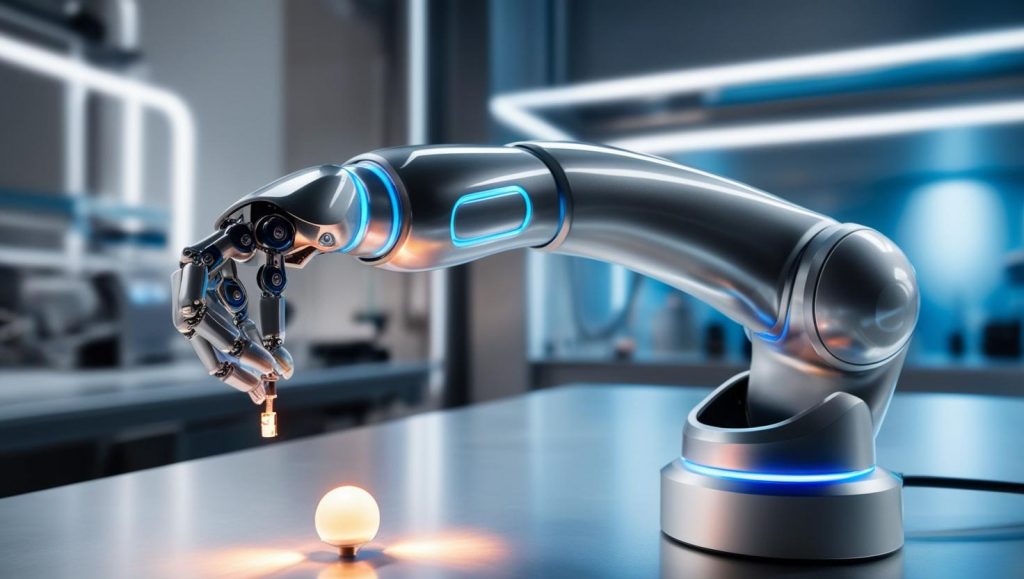The integration of artificial intelligence into various industries has sparked transformative changes, and the motion control market is no exception. The AI impact on motion control market is reshaping the landscape of automation, enabling unprecedented levels of precision, efficiency, and adaptability. This article delves into the multifaceted influence of AI on motion control systems, exploring its applications, benefits, challenges, and future potential. By examining the synergy between AI and motion control, we uncover how this convergence is driving innovation across industries such as manufacturing, robotics, aerospace, and healthcare.

Understanding the Convergence of AI and Motion Control Systems in Modern Industry
Motion control systems are the backbone of automation, governing the precise movement of machinery and robotic components. The AI impact on motion control market enhances these systems by embedding intelligent algorithms that optimize performance. AI-driven motion control systems leverage machine learning, neural networks, and predictive analytics to adapt to dynamic environments, ensuring seamless operations. This convergence allows industries to achieve higher accuracy in tasks such as assembly, packaging, and material handling. By incorporating AI, motion control systems can analyze vast datasets in real time, enabling machines to make autonomous decisions and improve operational efficiency. The AI impact on motion control market is thus a catalyst for smarter, more responsive automation solutions that meet the demands of modern industry.
Enhancing Precision and Efficiency Through AI-Driven Motion Control Technologies
Precision is a critical factor in industries reliant on motion control, and the AI impact on motion control market significantly elevates this aspect. AI algorithms enable motion control systems to fine-tune motor operations, reducing errors and minimizing waste. For instance, in manufacturing, AI-powered systems can adjust robotic arms to perform intricate tasks with pinpoint accuracy, enhancing product quality. Additionally, AI optimizes energy consumption by predicting the most efficient motion paths, contributing to cost savings and sustainability. The AI impact on motion control market also facilitates predictive maintenance, where AI analyzes sensor data to foresee potential system failures, reducing downtime and extending equipment lifespan. These advancements underscore AI’s role in driving efficiency and precision in motion control applications.
Applications of AI in Motion Control Across Diverse Industrial Sectors
The AI impact on motion control market extends across a wide range of industries, each benefiting from tailored AI applications. In manufacturing, AI enhances robotic assembly lines by enabling real-time adjustments to varying production demands. The automotive sector leverages AI-driven motion control for autonomous vehicle navigation and precision manufacturing of components. In aerospace, AI optimizes flight control systems, ensuring stability and safety. Healthcare applications include AI-powered robotic surgery systems, where motion control ensures precise movements during complex procedures. The AI impact on motion control market also influences logistics, with AI-guided automated guided vehicles (AGVs) streamlining warehouse operations. These diverse applications highlight AI’s transformative potential in enhancing motion control across sectors.
AI-Powered Robotics and the Evolution of Motion Control Systems
Robotics is a key domain where the AI impact on motion control market is profoundly evident. AI-powered robots equipped with advanced motion control systems can perform complex tasks with human-like dexterity. Machine learning algorithms enable robots to learn from their environments, adapting to new tasks without extensive reprogramming. For example, in industrial settings, AI-driven robots can handle delicate materials or assemble intricate components with high precision. The AI impact on motion control market also enables collaborative robots (cobots) to work alongside humans, adjusting their movements to ensure safety and efficiency. This evolution in robotics underscores how AI is redefining motion control, making systems more intelligent and versatile.
Overcoming Challenges in Integrating AI with Motion Control Technologies
While the AI impact on motion control market offers immense potential, it also presents challenges that must be addressed. One significant hurdle is the complexity of integrating AI algorithms with existing motion control infrastructure. Legacy systems may lack the computational power or compatibility required for AI implementation, necessitating costly upgrades. Additionally, ensuring data security is critical, as AI-driven systems rely on vast amounts of sensitive data. The AI impact on motion control market also faces challenges related to workforce upskilling, as employees need training to operate and maintain AI-enhanced systems. Overcoming these obstacles requires strategic investments in technology, cybersecurity, and education to fully harness AI’s benefits in motion control.
The Role of Machine Learning in Optimizing Motion Control Performance
Machine learning, a subset of AI, plays a pivotal role in the AI impact on motion control market by enabling systems to learn and improve over time. Machine learning models analyze historical data to identify patterns and optimize motion parameters, such as speed, torque, and trajectory. This capability is particularly valuable in dynamic environments where conditions change frequently. For instance, in semiconductor manufacturing, machine learning enhances motion control systems to maintain precision during high-speed wafer processing. The AI impact on motion control market also benefits from reinforcement learning, where systems continuously refine their performance based on real-time feedback. This adaptability ensures that motion control systems remain efficient and reliable in diverse applications.
Predictive Maintenance and Its Influence on Motion Control Reliability
Predictive maintenance is a game-changer in the AI impact on motion control market, enhancing system reliability and reducing operational costs. AI algorithms analyze data from sensors embedded in motion control systems to predict potential failures before they occur. By identifying anomalies in vibration, temperature, or motor performance, AI enables proactive maintenance, preventing costly downtime. The AI impact on motion control market also supports condition-based monitoring, where systems adjust their operations based on real-time health assessments. This approach extends the lifespan of motion control components and ensures consistent performance, making predictive maintenance a cornerstone of AI-driven automation.

AI and Motion Control in the Era of Industry 4.0 and Smart Factories
The advent of Industry 4.0 has accelerated the AI impact on motion control market, particularly in the context of smart factories. AI integrates with the Internet of Things (IoT) and big data analytics to create interconnected motion control systems that communicate seamlessly. In smart factories, AI-driven motion control systems enable real-time optimization of production processes, adapting to changes in demand or supply chain dynamics. The AI impact on motion control market also supports digital twins, virtual replicas of physical systems that allow manufacturers to simulate and optimize motion control performance. This synergy between AI, IoT, and motion control is driving the evolution of intelligent, automated factories that redefine industrial efficiency.
Future Prospects and Emerging Trends in AI-Driven Motion Control Systems
The AI impact on motion control market is poised for significant growth, with emerging trends shaping its future. One key trend is the development of edge AI, where AI algorithms are processed locally on motion control devices, reducing latency and enhancing real-time decision-making. Another trend is the integration of AI with 5G technology, enabling faster data transfer and improved connectivity for motion control systems. The AI impact on motion control market is also witnessing advancements in explainable AI, which enhances transparency in AI-driven decisions, fostering trust in automation systems. These trends indicate a future where AI and motion control systems are more integrated, efficient, and accessible across industries.
Ethical Considerations and Sustainability in AI-Enhanced Motion Control
As the AI impact on motion control market grows, ethical and sustainability considerations become increasingly important. AI-driven motion control systems must be designed to minimize environmental impact, optimizing energy usage and reducing waste. The AI impact on motion control market also raises ethical questions about automation’s impact on employment, as AI-enhanced systems may replace certain manual tasks. Addressing these concerns requires a balanced approach, where AI is used to augment human capabilities rather than replace them. Additionally, ensuring fairness and transparency in AI algorithms is crucial to prevent biases in motion control applications. By prioritizing ethics and sustainability, the AI impact on motion control market can contribute to a more equitable and environmentally conscious future.
Embracing the Transformative Power of AI in Motion Control
The AI impact on motion control market is a driving force behind the evolution of automation, offering unparalleled precision, efficiency, and adaptability. From enhancing robotics to enabling predictive maintenance and supporting smart factories, AI is redefining the capabilities of motion control systems. While challenges such as integration complexity and data security persist, the potential benefits far outweigh the obstacles. As industries continue to embrace AI-driven motion control, the market is set to witness exponential growth, paving the way for a future where automation is smarter, more sustainable, and more inclusive. The AI impact on motion control market is not just a technological advancement—it is a paradigm shift that will shape the future of industry.
FAQs
How does AI improve motion control systems?
AI enhances motion control systems by enabling real-time data analysis, predictive maintenance, and adaptive decision-making, resulting in improved precision, efficiency, and reliability.
Which industries benefit from the AI impact on motion control market?
Industries such as manufacturing, automotive, aerospace, healthcare, and logistics benefit from AI-driven motion control, leveraging its precision and automation capabilities.
What are the challenges of integrating AI with motion control?
Challenges include compatibility with legacy systems, data security concerns, and the need for workforce training to operate AI-enhanced motion control systems.
How does predictive maintenance contribute to the AI impact on motion control market?
Predictive maintenance uses AI to analyze sensor data, predict system failures, and schedule proactive maintenance, reducing downtime and enhancing system reliability.
What is the future of the AI impact on motion control market?
The future includes trends like edge AI, 5G integration, and explainable AI, driving faster, more transparent, and efficient motion control systems across industries.
